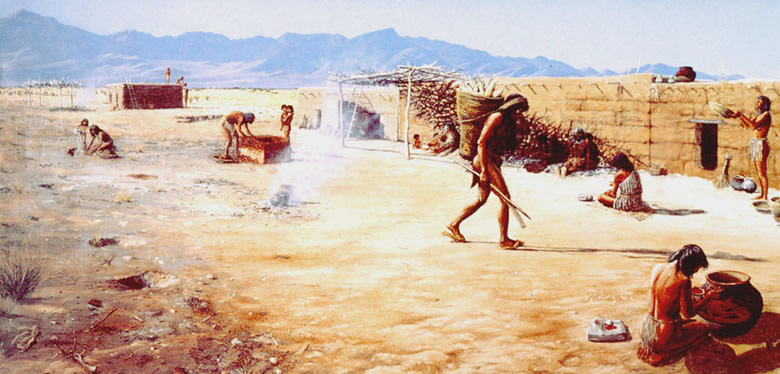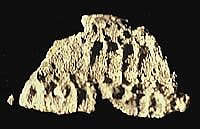
Coiled basketry impressions in baked
clay.
|
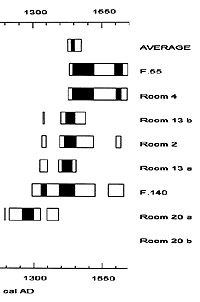
Chart showing the radiocarbon assays
from Firecracker. For each assay, the black bars show
the 67% probability age ranges while the open rectangles
show the full probability range.
|
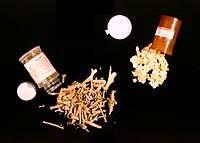
Egg shells and animal bone from fill
of Room 25, a pithouse beneath the pueblo room block
which was partially filled with trash by the pueblo
occupants.
|
|
Firecracker Pueblo's setting in the northern
Chihuahuan Desert and its relatively recent date—less
than 600 years old—allowed the survival of many organic
remains: burned and unburned wood, grass, stalks, wild and
cultivated seeds, animal bones, and various other items. These
organic remains have provided important information on the
diet and lifestyle, construction methods, and the age of the
site. The construction techniques are discussed in the Pueblo
and Pithouses sections.
Here we concentrate on the age of the site and its economy.
The Age of the Site
From the pottery types present at the site and
other characteristics, we knew that Firecracker Pueblo was
a fairly late site. The generally accepted age of the El Paso
phase was A.D. 1200-1400 and it was expected that radiocarbon
assays would place the site near the end of that period. Instead,
most of the dates fell within the fifteenth century.
In the Southwest, wood is not the preferred
material for radiocarbon dating because of the "old wood"
problem. Simply stated, the dry conditions mean that wood
can last several hundred years or more in some circumstances,
particularly at residential sites where building materials
are often reused. Thus, dating old wood provides an estimate
of when the tree was felled, not when the wood was last used.
To avoid this problem, only seasonally produced materials
were dated—short-lived plants and plant parts—including
corn, beans, grass, and agave stalks.
Eight radiocarbon assays were obtained as shown
in the chart. As is often the case when there are multiple
radiocarbon dates, some are in agreement with one another
and other dating methods and some are not. In this instance
there are two dates from Room 20 which are significantly different
from one another and from the other dates. The older of these
two dates would suggest occupation between the eighth and
tenth centuries and is much too early as it falls long before
the generally accepted beginning of the El Paso phase at about
A.D. 1200. The second date for this room spans the twelfth
and thirteenth centuries, is within the generally accepted
date of the El Paso phase, but is still significantly younger
than the other radiocarbon dates. This structure is one of
the pithouses in the larger group of east-west oriented pithouses.
The reason the dates from this structure fall considerably
younger than the other radiocarbon dates is uncertain, but
may well be because of contamination. This is the only structure
on which recent trash had been deposited and mixed with the
room fill. Among the debris were the remains of a calf, fireworks
debris, and oil deposits.
There are two radiocarbon dates from Room 13,
a pithouse in the group of four pithouses in the southern
part of the site. The 95% probability range on the average
of these two dates is A.D. 1401-1450, suggesting that the
pithouse occupation occurred during the first half of the
fifteenth century.
Turning to the pueblo, there are four radiocarbon
assays. Rooms 2 and 4 are part of the initial or core group
of four rooms of the pueblo. Feature 140 is a pit cut into
the pithouse (Room 25) that is beneath rooms of the western
part of the pueblo, and Feature 55 is a pit associated with
the pueblo occupation and beneath the last rooms at the west
end of the pueblo. The radiocarbon dates from these rooms
and features are not significantly different from one another
and have a 95% probability range of A.D. 1429-1491, perhaps
suggesting a slightly later occupation than that of the pithouses.
Except for the dates from Room 20, radiocarbon
dates from Firecracker Pueblo are not, in statistical terms,
significantly different from one another. The six remaining
dates have a combined 95% probability range of A.D. 1423-1473.
The radiocarbon dates from Firecracker are important
because they provide the first hard evidence that the El Paso
phase flourished in the fifteenth century. In fact, these
dates narrow the gap between the collapse of the pueblo system
in the Jornada region and the first Spanish entrada in the
late sixteenth century. When the Spanish entered the El Paso
area, they found hunters and gatherers who apparently did
not make pottery and grow corn. These Manso Indians may or
may not be related to the earlier peoples in the area.
Food Remains
The food remains found at the site are informative
for several reasons. First they show that the inhabitants
of Firecracker were ranging rather widely and making use of
many plants and a fair number of animals. The bones from the
site are mostly those of rabbits, jackrabbit and cottontail,
with a few small birds, rodents, snakes, and lizards. In addition
to local small game, an occasional deer or antelope was killed
elsewhere, field dressed and butchered—only meat bones
and a few bones useful for tools were brought back to the
site. Animal bones were much less common than plant remains.
Among the identified plant remains that are
probably food items or residue are corn cobs and kernels,
common and tepary beans, the rinds of cucurbits (squash) and
gourds, amaranth seeds, purslane seeds, mesquite seeds and
pods, tornillo pods, yucca leaves, agave leaves, sotol leaves,
datil seeds, prickly pear seeds, and pinyon nuts. A large
number of flotation samples was analyzed from floors, hearths,
room fill. Samples of the fill from many of outside features
were analyzed. This study is the only analysis of this sort
for a pueblo site and the largest and best-defined analysis
for any El Paso phase site. The native plant species identified
at Firecracker parallel wild food species reported for the
Mescalero Apache of this region.
This chart
shows the relative frequency of different kinds of plants
in the 128 flotation samples that were analyzed from Firecracker.
One of the most significant findings is
the widespread occurrence of both corn cobs and corn kernels
in samples from many pueblo and pithouse contexts. This shows
a heavy reliance upon corn and probably other cultigens. Sites
from earlier periods in the region have yielded negligible
amounts of corn and very low percentages of flotation samples
with corn. Some have suggested that the reliance of El Paso
phase peoples on corn may have contributed to the demise of
their culture.
|
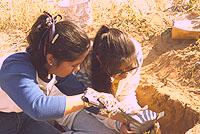
Students collecting flotation samples
from the fill of one of the pithouses. The analysis
of many such samples from Firecracker Pueblo provided
a great deal of very useful information about what people
were eating and how they used the landscape.
Click images to enlarge
|
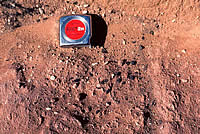
Charred corn kernels and beans in
fill of Room 13, the southernmost pithouse at Firecracker.
Most of the abandoned pithouses (or the depressions
they left) were filled with refuse during the pueblo
occupation.
|
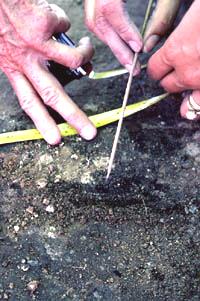
Exposing a burned corn cob on the
floor of Room 20, one of the pithouses due west from
the Firecracker pueblo.
|
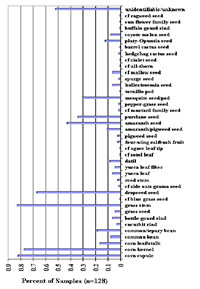
This chart shows the relative frequency
of different kinds of plants in the 128 flotation samples
that were analyzed from Firecracker.
|
|
